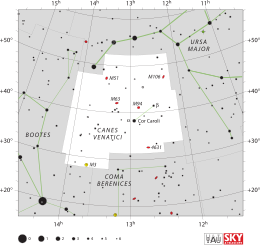|
Il Gruppo di M51 è un gruppo di galassie situato nella costellazione dei Cani da Caccia. Il gruppo prende il nome dalla componente principale, la Galassia Vortice, o M51. Altri membri importanti sono la NGC 5195, compagna di M51 e la Galassia Girasole[1][2][3][4].
Membri
La tabella sottostante indica i membri principali:
Membri del Gruppo di M51
| Nome
|
Tipo[5]
|
R.A. (J2000)[5]
|
Dec. (J2000)[5]
|
Redshift (km/s)[5]
|
Magnitudine apparente[5]
|
| M51B (NGC 5195)
|
SB0 pec
|
13h 29m 59,6s
|
+47° 15′ 58″
|
465 ± 10
|
10,5
|
| NGC 5005
|
Sb II
|
13h 10m 56,2s
|
+37° 03′ 33″
|
946 ± 5
|
10,6
|
| NGC 5023
|
Scd
|
13h 12m 12,6s
|
+44° 02′ 28″
|
407 ± 1
|
12,9
|
| NGC 5229
|
SB(s)d
|
13h 34m 02,8s
|
+47° 54′ 56″
|
364 ± 8
|
14,3
|
| Galassia Girasole (M63)
|
SA(rs)bc
|
13h 15m 49,3s
|
+42° 01′ 45″
|
504 ± 4
|
9,3
|
| UGC 8313
|
SB(s)c
|
13h 13m 53,9s
|
+42° 12′ 31″
|
593 ± 4
|
14,4
|
| UGC 8331
|
IAm
|
13h 15m 30,3s
|
+47° 29′ 56″
|
260 ± 5
|
14,6
|
| Galassia Vortice (M51A)
|
SA(s)bc pec
|
13h 29m 52,7s
|
+47° 11′ 43″
|
463 ± 3
|
9,0
|
Anche IC 4263 e UGC 8320 sono possibili candidati ad essere membri, tuttavia ancora nessuna misurazione ha confermato o smentito tale supposizione.
Gruppi nelle vicinanze
Il Gruppo di M51 si trova a sud-est del Gruppo di M101 e del Gruppo di NGC 5866[6]: la distanza di questi gruppi e dei loro membri da noi è simile, e questo fa pensare ad un possibile grande ammasso che comprenda tutti e tre i gruppi, con una struttura allungata e con galassie abbastanza sparse tra loro[6]. Tuttavia, la maggior parte dei metodi di identificazione indicano questi tre gruppi come ammassi separati.
Note
- ^ a b c d A. Garcia, General study of group membership. II - Determination of nearby groups, in Astronomy and Astrophysics Supplement, vol. 100, 1993, pp. 47–90.
- ^ a b c d e f G. Giuricin, C. Marinoni, L. Ceriani, A. Pisani, Nearby Optical Galaxies: Selection of the Sample and Identification of Groups, in Astrophysical Journal, vol. 543, n. 1, 2000, pp. 178–194, DOI:10.1086/317070, arXiv:astro-ph/0001140.
- ^ R. B. Tully, Nearby Galaxies Catalog, Cambridge, Cambridge University Press, 1988, ISBN 0-521-35299-1.
- ^ P. Fouque, E. Gourgoulhon, P. Chamaraux, G. Paturel, Gourgoulhon, Chamaraux e Paturel, Groups of galaxies within 80 Mpc. II - The catalogue of groups and group members, in Astronomy and Astrophysics Supplement, vol. 93, 1992, pp. 211–233.
- ^ a b c d e NASA/IPAC Extragalactic Database, su Results for various galaxies. URL consultato il 19 ottobre 2006.
- ^ a b L. Ferrarese, H. C. Ford, J. Huchra, R. C. Kennicutt Jr., J. R. Mould, S. Sakai, W. L. Freedman, P. B. Stetson, B. F. Madore, B. K. Gibson, J. A. Graham, S. M. Hughes, G. D. Illingworth, D. D. Kelson, L. Macri, K. Sebo, N. A. Silbermann, A Database of Cepheid Distance Moduli and Tip of the Red Giant Branch, Globular Cluster Luminosity Function, Planetary Nebula Luminosity Function, and Surface Brightness Fluctuation Data Useful for Distance Determinations, in Astrophysical Journal Supplement, vol. 128, n. 2, 2000, pp. 431–459, DOI:10.1086/313391, arXiv:astro-ph/9910501.
Voci correlate
Altri progetti
|

